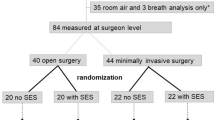Abstract
Background
Surgical smoke production is inevitable during surgical procedures. Although many workplaces have adopted smoke-free environments, healthcare workers, especially surgeons, continue to be exposed to surgical smoke.
Methods
From February 2013 to March 2013, a total of 20 patients underwent transperitoneal laparoscopic nephrectomy for renal cell carcinoma. A 5-L gas sample was collected 30 min after the electrocautery device was first used and was analyzed by gas chromatography and mass spectrometry. Cancer risk was calculated for carcinogenic compounds and hazard quotient was calculated for noncarcinogenic compounds using US Environmental Protection Agency guidelines.
Results
Twenty patients with a median age of 57.5 years were enrolled in the study. Eighteen volatile organic compounds were detected by Japanese indoor air standards mix analysis. The cancer risks were ethanol, 5.10 × 10−5 ± 6.35 × 10−5; 1,2-dichloroethane, 4.75 × 10−3 ± 7.42 × 10−4; benzene, 1.09 × 10−3 ± 4.33 × 10−4; ethylbenzene, 2.87 × 10−5 ± 1.32 × 10−5; and styrene, 2.94 × 10−6 ± 1.16 × 10−6. The hazard quotients were acetone, 1.88 × 10−2 ± 7.63 × 10−3; hexane, 1.48 × 10−1 ± 8.70 × 10−2; benzene, 4.66 ± 1.85; toluene, 2.61 × 10−2 ± 7.23 × 10−3; p-xylene, 1.81 × 10−1 ± 6.45 × 10−2; o-xylene, 2.40 × 10−2 ± 3.33 × 10−2; and styrene, 5.15 × 10−3 ± 2.03 × 10−3.
Conclusions
For five carcinogenic compounds detected, the cancer risk was greater than negligible. For 1,2-dichloroethane and benzene, the risk was classified as unacceptable. Analysis of noncarcinogenic compounds showed that risk reduction measures are needed for benzene. Even though surgical smoke is not an immediate health hazard, operating room personnel should be aware of the potential long-term health risks associated with exposure.

Similar content being viewed by others
References
Fan JK, Chan FS, Chu KM (2009) Surgical smoke. Asian J Surg 32:253–257
King B, McCullough J (2006) Health hazard evaluation report, NIOSH 2001-0030-3020. http://www.cdc.gov/niosh/hhe/reports/pdfs/2001-0030-3020.pdf
Baan R, Grosse Y, Straif K, Secretan B, El Ghissassi F, Bouvard V, Benbrahim-Tallaa L, Guha N, Freeman C, Galichet L, Cogliano V (2009) A review of human carcinogens–Part F: chemical agents and related occupations. Lancet Oncol 10:1143–1144
Technical Manual 1003: Guidance on Preparing a Risk Assessment Protocol for Air Contaminant Emissions. http://www.nj.gov//dep/aqpp/risk.html
Guidelines for Carcinogen Risk Assessment, March 2005, Risk Assessment Forum. http://cfpub.epa.gov/ncea/cfm/recordisplay.cfm?deid=116283
Integrated Risk Information System (IRIS). http://www.epa.gov/iris
Occupational Safety and Health Administration technical links. https://www.osha.gov/SLTC/laserelectrosurgeryplume/index.html
Ullmann’s Encyclopedia of Industrial Chemistry (2012) Choice: Current Reviews for Academic Libraries 50:452–452
Doucette WJ, Hall AJ, Gorder KA (2010) Emissions of 1,2-dichloroethane from holiday decorations as a source of indoor air contamination. Ground Water Monit Remed 30:67–73
Kasper DL, Harrison TR (2005) Harrison’s principles of internal medicine, 16th edn. McGraw-Hill, Medical Publishing Division, New York
Acknowledgments
This research was supported by Kyungpook National University Research Fund 2012, and financially supported by the “Advanced medical new material (fiber) development program” through the Ministry of Trade, Industry & Energy (MOTIE) and Korea Institute for Advancement of Technology (KIAT).
Author information
Authors and Affiliations
Corresponding author
Rights and permissions
About this article
Cite this article
Choi, S.H., Kwon, T.G., Chung, S.K. et al. Surgical smoke may be a biohazard to surgeons performing laparoscopic surgery. Surg Endosc 28, 2374–2380 (2014). https://doi.org/10.1007/s00464-014-3472-3
Received:
Accepted:
Published:
Issue Date:
DOI: https://doi.org/10.1007/s00464-014-3472-3




